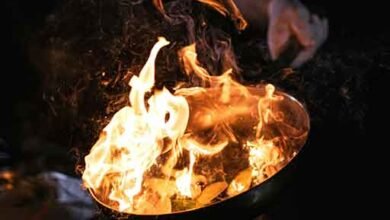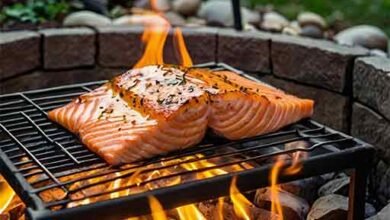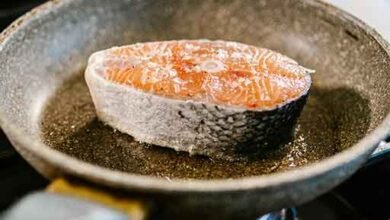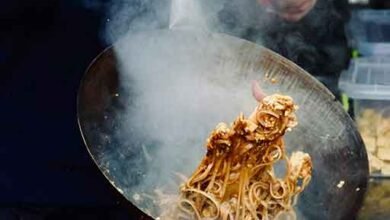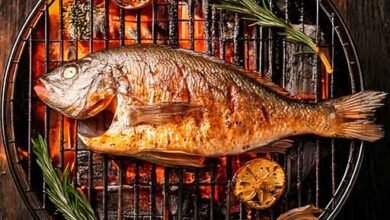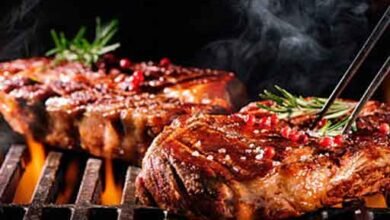Dry Heat Cooking Methods
Dry heat cooking methods do not require additional moisture during the cooking process. Dry heat cooking methods used with fish and shellfish are broiling and grilling, roasting commonly called baking when used with fish and shellfish, frying, pan-frying, and deep-frying.
Dry heat cooking applies heat either directly, by subjecting the food to the heat of a flame, or indirectly, by surrounding the food with hot air or hot fat. Although some of these techniques use fat, they are dry heat cooking techniques because liquid fat does not contain water. Fats can be used for cooking at higher temperatures than water-based liquids, resulting in differences in the flavor, color, and texture of the final product.
-

Baking
The Ultimate Guide to Baking: From Ancient Art to Modern Science There’s a unique kind of magic that happens when you slide a pan into a warm oven. It’s in the air, a comforting aroma of melting butter, caramelizing sugar, or rising bread that fills a home and speaks a universal language of comfort and care. Baking is more than just a method of cooking; it’s a process of transformation. It turns humble ingredients—flour, sugar, eggs, and butter—into everything from crusty, rustic loaves and elaborate pastries to simple, soul-satisfying cookies.…
-

Roasting
Introduction: Beyond Baking – The Transformative Power of Roasting Fish In the culinary lexicon, the terms “baking” and “roasting” are often used interchangeably, particularly when it comes to fish. A recipe might call for “baked cod,” while another suggests “roasted salmon,” leaving the home cook to wonder if there is any meaningful difference. The distinction, while subtle, is the very foundation of culinary mastery. To view roasting not as a passive act of placing fish in an oven, but as an active, dynamic technique is to unlock a world of…
-

Smoking
Smoking is a dry heat cooking method used to flavor, color, and preserve food for immediate use. When smoking, heat is transferred to the surface of the food by convection and then into the food by conduction. Smoking involves burning wood or wood chips to produce smoke vapor, which contains compounds that help preserve and flavor the food. Smoky flavors can also be added by exposing uncooked items such as cheese and nuts to smoke without heat. Smoking preserves flavors and preserves food for longer storage. (Note that the FDA’s…
-

Sauteing
Sautéing is a dry-heat cooking method that uses conduction to transfer heat from a hot sauté pan to the food. The heat then enters the food through conduction. High temperatures are used for sautéing, and the food is usually cut into thin or small pieces to promote cooking. To properly sauté food, start by heating a sauté pan on the stove, then add a small amount of fat. The fat should just cover the bottom of the pan. Heat the fat to just enough to cover the bottom of the…
-

Fire Pit Cooking
What is a fire pit cooking? Fire pit cooking is a dry heat cooking method In the most basic sense, a fire pit is just that “A Pit of Fire“. What started as a simple hole in the ground, in which burning wood supplied heat for warmth and cooking, has become more practical and safe over the centuries through design. Many of us think of a firepit as simply a vessel that burns wood, over which a suspended grill or hotplate can be fitted to cook food. The most basic…
-

Deep Frying
Deep frying is a dry heat cooking method that uses conduction and convection to transfer heat to food immersed in hot fat. Although conceptually similar to boiling, deep frying is not a moist heat cooking method because the fat used does not contain water. A key difference between boiling and deep frying is the temperature of the cooking medium. The boiling point, 212 °F (100 °C), is the hottest temperature at which food can be cooked in water. At this temperature, most foods require a longer cooking time and surface…
-

Pan-frying
Pan-frying shares characteristics with both sautéing and deep-frying. It is a dry heat cooking method in which heat is transferred from the pan to the food by conduction, using a moderate amount of fat (ie more than frying; less than deep frying). Heat is also transferred from the hot fat to the food by convection. Pan-fried foods, such as eggplant slices or chicken bone-in pieces, are usually coated in breading. It forms a seal that keeps the food moist and prevents hot fat from seeping into the food and turning…
-

Stir-Frying
Stir-frying is an ancient Chinese cooking technique similar to sautéing. A wok is used instead of a sauté pan; The curved sides and rounded bottom of the wok disperse heat efficiently and facilitate the almost constant tossing and stirring required for this cooking method. When stir-frying, the heat is kept at a constant high temperature. The wok should be heated till it smokes. When the pan is well heated, a few drops of water will evaporate immediately when added to the pan. The fat used for stir-frying should have a…
-

Barbecue
Barbecue is a dry heat cooking method that involves baking or roasting. In traditional barbecue, large, usually tough, cuts of meat are cooked in a semi-enclosed oven (called a pit) by natural convection with smoke from a low-temperature wood fire, usually Below 225°F (107°C). True barbecue is a slow process, requiring hours of low-temperature heat and smoke to tenderize tough cuts or whole carcasses. Doneness is not determined by internal temperature but by softness and feel. The meat should be tender between the bones. In the case of beef, when…
-

Grilling
Grilling is similar to broiling, grilling uses a heat source located below the cooking surface. Heat is transferred to the food via infrared radiant heat and conduction between the food and the grill rack itself. Grills can be gas, or electric, or they can Charcoal or burn wood. Solid metal pans with grooved surfaces can also be used to pan-grill foods. Grilled foods are characterized by their crusty exterior and aromatic flavors, and are often cross-hatched toward presentation. A gas or electric grill controls the cooking temperature by adjusting the…



